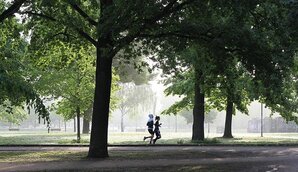Masked Exercise in the Age of COVID-19
Due to the ongoing COVID-19 pandemic and masking efforts, many people have significantly reduced their daily amount of outdoor physical activity. For example, this study by the Keck School of Medicine at the University of Southern California found that over half of children aged 5 to 13 have had decreased physical activity levels, with children aged 9 to 13 having an even sharper decline. The closure of gyms and other indoor fitness facilities means that it is even more important for people to find alternate ways to workout. Decreased physical activity can have long-term implications on health, especially since social distancing efforts won’t be reduced anytime soon. Lack of exercise has been linked to a variety of chronic diseases, including diabetes, liver disease, and heart disease. Now that many schools and jobs are remote, it is especially important to find a way to remain active.
Luckily, most outdoor recreation areas remain open for exercise and are a great alternative to indoor gyms. Parks and hiking trails provide ample space to allow for safe social distancing, defined as keeping at least a six-foot distance between yourself and others. Even in outdoor spaces, it is important to continue wearing masks, since viral particles can be transmitted in droplets while speaking, breathing, sneezing, or coughing. Although outdoor spaces easily allow for safe exercise, many are still hesitant to workout outside due to mask-wearing regulations. Common objections to mask-wearing during exercise is difficulty breathing during exercise and impact on performance. In the most extreme cases, individuals are worried that mask-wearing causes increased carbon dioxide levels in the blood, which could potentially cause a condition called hypoxia, in which carbon dioxide displaces oxygen in the blood.
Luckily, most outdoor recreation areas remain open for exercise and are a great alternative to indoor gyms. Parks and hiking trails provide ample space to allow for safe social distancing, defined as keeping at least a six-foot distance between yourself and others. Even in outdoor spaces, it is important to continue wearing masks, since viral particles can be transmitted in droplets while speaking, breathing, sneezing, or coughing. Although outdoor spaces easily allow for safe exercise, many are still hesitant to workout outside due to mask-wearing regulations. Common objections to mask-wearing during exercise is difficulty breathing during exercise and impact on performance. In the most extreme cases, individuals are worried that mask-wearing causes increased carbon dioxide levels in the blood, which could potentially cause a condition called hypoxia, in which carbon dioxide displaces oxygen in the blood.
Image Source: palinska
To assess the validity of these concerns, the University of Saskatchewan performed a study in which otherwise healthy participants wore either a cloth mask, surgical mask, or no mask during exercise. Arterial oxygen saturation, or percentage of total hemoglobin binding sites available for oxygen bindings, and tissue oxygenation, or the oxygen level found in the tissues of the body, are both measures that give insight into if a person has a healthy oxygen level. Both of these measurements, along with and rating of perceived exertion and heart rate were shown to have no significant difference between the groups. Another similar study with 16 healthy male participants found that heart rate, respiratory rate, blood pressure, oxygen saturation, and time to exhaustion do not change when participants wear a surgical mask, a N95 respirator, or no mask at all.
Based on these two preliminary studies, healthy adults can safely exercise with masks on without any real danger. Combined with safe distancing and use of outdoor spaces, mask-wearing would allow individuals to safely spend time outdoors while remaining in good physical shape. As people adapt to a dramatically different lifestyle during the pandemic, continuing to exercise outdoors is extremely vital to preventing the onset of obesity, cardiovascular disease, and depression.
Based on these two preliminary studies, healthy adults can safely exercise with masks on without any real danger. Combined with safe distancing and use of outdoor spaces, mask-wearing would allow individuals to safely spend time outdoors while remaining in good physical shape. As people adapt to a dramatically different lifestyle during the pandemic, continuing to exercise outdoors is extremely vital to preventing the onset of obesity, cardiovascular disease, and depression.
Featured Image Source: wal_172619
RELATED ARTICLES
|
Vertical Divider
|
Vertical Divider
|
Vertical Divider
|






